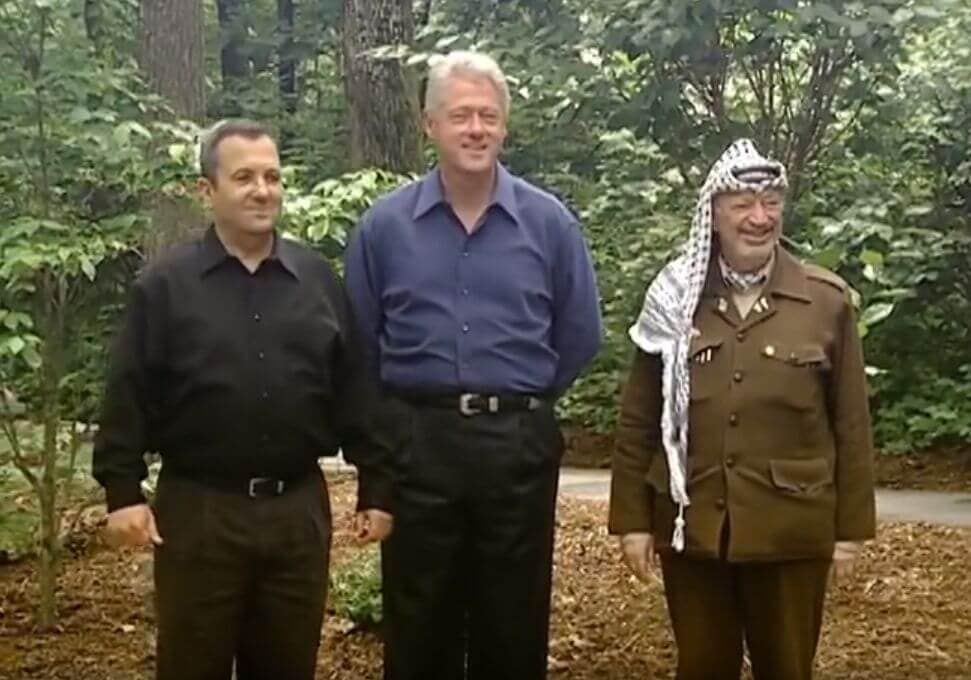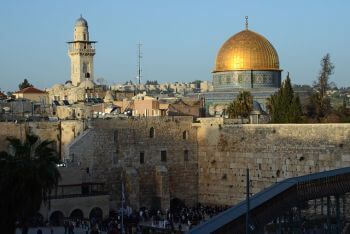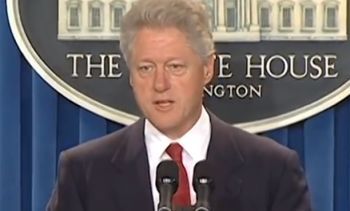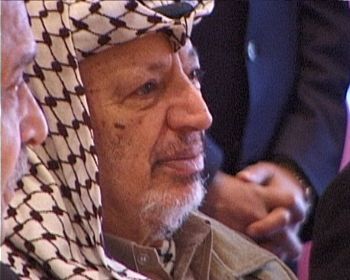“Why doesn’t Israel simply give the Palestinians what they are asking for and bring the conflict to an end?”
“What do you want from the Palestinians? Israel refuses to give them their own state so of course the Palestinians resort to terrorism and armed conflict!”
These two refrains are heard constantly from the pro-Palestinian camp in parliaments and college campuses around the world.
The problem with this line of questioning is that it ignores the fact that Israel has tried to make peace and has tried to offer the Palestinians as much as it can. The Camp David II summit of 2000 is a case in point.
Join the fight for Israel’s fair coverage in the news
Camp David II
The last major attempt to resolve the issues between Israel and the Palestinians took place in July 2000. US President Bill Clinton invited Israeli prime minister Ehud Barak and Palestinian Authority chairman Yasser Arafat to meet at Camp David, the president’s retreat in western Maryland.
Years before, in 1979, Camp David had been the place where US President Jimmy Carter hosted Israeli prime minister Menachem Begin and Egyptian president Anwar Sadat for talks that eventually led to the Israeli-Egyptian peace treaty. It was hoped that Camp David’s relaxed setting would facilitate a similar breakthrough for the Israelis and Palestinians. Hence the name, Camp David II.
The Oslo Accords, signed in 1993 between Arafat and the late Israeli prime minister Yitzhak Rabin, called for a final status agreement between the two sides within five years of the Palestinians being given their own autonomy.
The Palestinians were not happy about coming to Camp David II, fearing they would be pressured into making concessions. But Arafat accepted the invitation and on July 11, the Israeli and Palestinian delegations arrived in Camp David.
The approach for this summit was “all or nothing.” The two sides were to strive to reach an agreement regarding territory and status of settlements, Jerusalem and the Temple Mount, refugees and the Palestinian call for the right of return, and security arrangements. There were to be no partial or intermediate agreements.

The Positions
Territory: The Palestinians were demanding the entire West Bank and Gaza Strip but were willing to accept land swaps from within Israel for any part of these territories which Israel would hold on to. Prime Minister Barak offered the Palestinians 73% of the West Bank and 100% of the Gaza Strip with a plan for them to eventually control 91% of the West Bank, with an elevated highway and railroad to connect the two territories.
The Palestinians would also receive the equivalent of one percent of the West Bank by taking control of the Halutza Sand region next to the Gaza Strip. The plan would have required Israel to forcibly evacuate people from their homes in 63 settlements, while allowing Israel to annex the settlements of Gush Etzion and Maale Adumim where a few hundred thousand Israelis reside.
 Jerusalem: Israel proposed giving the Palestinians “custodianship” over the Temple Mount and “administration” over the Muslim and Christian Quarters of the Old City and all Islamic and Christian holy sites. They would be allowed to raise the Palestinian flag in all these locations.
Jerusalem: Israel proposed giving the Palestinians “custodianship” over the Temple Mount and “administration” over the Muslim and Christian Quarters of the Old City and all Islamic and Christian holy sites. They would be allowed to raise the Palestinian flag in all these locations.
Israel felt that it could not relinquish its sovereignty over these areas due to security concerns. The Israeli neighborhoods in eastern Jerusalem would remain under Israeli sovereignty and the Palestinians would be given civilian autonomy in their areas. The Palestinians would create the city of Al-Quds to be the capital of Palestine. This city would include small cities and villages on the outskirts of Jerusalem.
Refugees: The Palestinian demand for a “right of return” for over 700,000 refugees from the Israeli War of Independence in 1948 and their descendants numbering in the millions, was not one which Israel could agree to. The influx of millions of Palestinians would amount to the end of the democratic Jewish state of Israel.
Instead, Israel proposed that a maximum of 100,000 refugees be allowed to enter Israel for family reunification and other humanitarian considerations. All remaining Palestinian “refugees” would be settled in the new Palestinian state or in third-party countries. An international fund worth $30 billion which Israel would contribute to, would register claims of property lost by Palestinian refugees and provide appropriate compensation.
Security: The number one concern for Israeli negotiators related to security. Israel demanded that the Palestinian state be demilitarized and that it commit to dismantling all terrorist groups.
Israel proposed that an international force be stationed in the Jordan Valley, with Palestine controlling the border crossing albeit under Israeli observation, and that Israel maintain a permanent security presence along 15% of the border between Jordan and Palestine. Israel also asked that be allowed to set up radar stations inside the Palestinian state and that it be able to deploy troops in the Palestinian state in a case of emergency.
A final peace: Israel’s number one demand was that for it to make all these concessions, Arafat must declare an end to the conflict and make no further demands of Israel in the future.
White House aides who were present at Camp David II were surprised at how far Barak was willing to go and felt that his offer met most of what the Palestinians were asking for.
But Arafat rejected the Israeli offer.
Instead of an agreement, the parties issued a declaration which said that “the two sides agreed that the aim of their negotiations is to put an end to decades of conflict and achieve a just and lasting peace” and that “the two sides commit themselves to continue their efforts to conclude an agreement on all permanent status issues as soon as possible.”
Clinton’s Post-Camp David II Proposals

President Clinton did not give up on the mission to secure an actual agreement and following months of back and forth, presented a new proposal to both sides in December 2000 in which he pushed Israel to make even more concessions.
Territory: The Clinton proposal offered the Palestinians 94%-96% of the West Bank plus land swaps of up to 3% in Israel to give the Palestinians close to 100% of the land mass they sought.
Security: To provide Israel with its security needs, the Israeli army would withdraw from the Palestinian areas gradually over the course of three years while an international force would be gradually introduced into the region. Israel would maintain a small presence on the Jordan Valley for an additional three years, but under the authority of the international force.
Israel would be allowed to have an “early-warning” station in the West Bank but with the presence of a Palestinian liaison, and in the event of an “imminent and demonstrable threat to Israel’s security,” an arrangement would be made for IDF deployment to the West Bank on an emergency basis. And finally, the state of Palestine would be “non-militarized” but would have a strong security force.
Jerusalem: Clinton proposed that Arab neighborhoods be in Palestine, that Jewish neighborhoods be Israeli, that the Palestinians would have sovereignty over the Temple Mount and that the Israelis would maintain sovereignty over the Western Wall and the “holy space” which the Western Wall is part of. No excavations around the wall or under the Temple Mount would take place without mutual consent.
Related reading: Jewish Ties to the Temple Mount: What’s the Story?
Refugees: Clinton proposed that to address the refugee issue, the new state of Palestine would be the homeland for refugees displaced in the 1948 war and afterward. In addition, an international effort would be made to compensate refugees and assist them in finding houses in the new state of Palestine, in their new current host countries, in other willing nations, or in Israel.
A final peace: Clinton agreed with the Israeli demand that the agreement had to clearly mark the end of the conflict and put an end to all violence.
The Israeli government voted to accept the proposal on December 27, 2000. Arafat never gave Clinton an official “no,” but he also never said “yes,” amounting to a rejection of the proposal — an unceremonious ending for Camp David II and Clinton’s peacemaking efforts.
According to notes taken by White House officials during the Camp David II meetings trying to convince the Palestinian leader to accept the agreement, Arafat was quoted as saying:
The Palestinian leader who will give up Jerusalem has not yet been born. I will not betray my people or the trust they have placed in me. Don’t look to me to legitimize the occupation. No one can continue indefinitely to impose domination by military force – look at South Africa. Our people will not accept less than their rights as stated by international resolutions and international legality.
Some said that the Palestinians felt that the land swaps being offered them were inferior lands to that which they were giving up in the West Bank, that they needed to have complete sovereignty over the entirety of eastern Jerusalem, including the Western Wall, and recognition of a full right of return for Palestinian refugees.
The Second Intifada Begins

Not only did the Palestinians reject the Israeli offer, but soon after, the Second Intifada, a violent Palestinian uprising began. More than 1,000 innocent Israeli civilians were killed in a Palestinian campaign of suicide bombings and shootings.
President Clinton blamed Arafat for the failure of the two sides to reach an agreement:
I regret that in 2000 Arafat missed the opportunity to bring that nation into being.
Dennis Ross, the chief US negotiator, concluded that Arafat was never truly open to a two-state solution. Rather, Arafat and the Palestinians had clung to their desire for
a one-state solution. Not independent, adjacent Israeli and Palestinian states, but a single Arab state encompassing all of Historic Palestine.
Palestinian officials confirmed that the Second Intifada was premeditated all along. Speaking at the Ein Al-Hilweh Palestinian refugee camp in Lebanon, PA Communications Minister, Imad Al-Faluji said,
Whoever thinks that the Intifada broke out because of the despised Sharon’s visit to the Al-Aqsa Mosque, is wrong, even if this visit was the straw that broke the back of the Palestinian people. This Intifada was planned in advance, ever since President Arafat’s return from the Camp David negotiations, where he turned the table upside down on President Clinton. [Arafat] remained steadfast and challenged [Clinton]. He rejected the American terms and he did it in the heart of the US.
Related reading: Did Ariel Sharon Start the Second Intifada?
Sadly and tragically for both Israelis and Palestinians, the Palestinian leadership continued its obstructionist ways by not replying to an even more generous offer made by Israeli prime minister Ehud Olmert in 2008, and by stonewalling negotiations even when Prime Minister Benjamin Netanyahu enacted a 10-month freeze on settlement activity, then a key precondition for talks by both the Palestinians and the Obama administration.
So, asking why Israel doesn’t bring the conflict to an end and give the Palestinians what they want isn’t the right question. Here’s the better question:
Why do the Palestinians continue to avoid making peace with Israel?
Liked this article? Follow HonestReporting on Twitter, Facebook, Instagram and TikTok to see even more posts and videos debunking news bias and smears, as well as other content explaining what’s really going on in Israel and the region.
New! Skip the social scroll and get the latest from HonestReporting via Telegram.
Images: leaders via YouTube/clintonlibrary42; Jerusalem CC BY-NC-ND Maggie & Rick; Clinton via YouTube/clintonlibrary42; Arafat via Wikimedia Commons;
Before you comment on this article, please note our Comments Policy. Any comments deemed to be in breach of the policy will be removed at the editor’s discretion.

